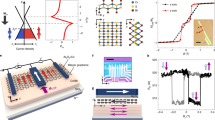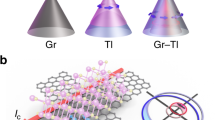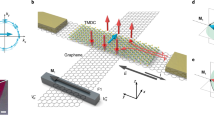Abstract
Exploiting 2D materials for spintronic applications can potentially realize next-generation devices featuring low power consumption and quantum operation capability1,2,3. The magnetic exchange field (MEF) induced by an adjacent magnetic insulator enables efficient control of local spin generation and spin modulation in 2D devices without compromising the delicate material structures4,5. Using graphene as a prototypical 2D system, we demonstrate that its coupling to the model magnetic insulator (EuS) produces a substantial MEF (>14 T) with the potential to reach hundreds of tesla, which leads to orders-of-magnitude enhancement of the spin signal originating from the Zeeman spin Hall effect. Furthermore, the new ferromagnetic ground state of Dirac electrons resulting from the strong MEF may give rise to quantized spin-polarized edge transport. The MEF effect shown in our graphene/EuS devices therefore provides a key functionality for future spin logic and memory devices based on emerging 2D materials in classical and quantum information processing.
This is a preview of subscription content, access via your institution
Access options
Subscribe to this journal
Receive 12 print issues and online access
$259.00 per year
only $21.58 per issue
Buy this article
- Purchase on Springer Link
- Instant access to full article PDF
Prices may be subject to local taxes which are calculated during checkout




Similar content being viewed by others
References
Tombros, N., Jozsa, C., Popinciuc, M., Jonkman, H. T. & van Wees, B. J. Electronic spin transport and spin precession in single graphene layers at room temperature. Nature 448, U571–U574 (2007).
Han, W., Kawakami, R. K., Gmitra, M. & Fabian, J. Graphene spintronics. Nature Nanotech. 9, 794–807 (2014).
Xu, X., Yao, W., Xiao, D. & Heinz, T. F. Spin and pseudospins in layered transition metal dichalcogenides. Nature Phys. 10, 343–350 (2014).
Haugen, H., Huertas-Hernando, D. & Brataas, A. Spin transport in proximity-induced ferromagnetic graphene. Phys. Rev. B 77, 115406 (2008).
Yang, H. X. et al. Proximity effects induced in graphene by magnetic insulators: first-principles calculations on spin filtering and exchange-splitting gaps. Phys. Rev. Lett. 110, 046603 (2013).
Li, B. et al. Superconducting spin switch with infinite magnetoresistance induced by an internal exchange field. Phys. Rev. Lett. 110, 097001 (2013).
Semenov, Y. G. Spin field effect transistor with a graphene channel. Appl. Phys. Lett. 91, 153105 (2007).
Abanin, D. A. et al. Giant nonlocality near the Dirac point in graphene. Science 332, 328–330 (2011).
Abanin, D. A., Gorbachev, R. V., Novoselov, K. S., Geim, A. K. & Levitov, L. S. Giant spin-Hall effect induced by the Zeeman interaction in graphene. Phys. Rev. Lett. 107, 096601 (2011).
Moodera, J. S., Santos, T. S. & Nagahama, T. The phenomena of spin-filter tunnelling. J. Phys. Condens. Matter 19, 165202 (2007).
Wei, P. et al. Exchange-coupling-induced symmetry breaking in topological insulators. Phys. Rev. Lett. 110, 186807 (2013).
Swartz, A. G., Odenthal, P. M., Hao, Y., Ruoff, R. S. & Kawakami, R. K. Integration of the ferromagnetic insulator EuO onto graphene. ACS Nano 6, 10063–10069 (2012).
Swartz, A. G. et al. Integrating MBE materials with graphene to induce novel spin-based phenomena. J. Vac. Sci. Technol. B 31, 04D105 (2013).
Nair, R. R. et al. Spin-half paramagnetism in graphene induced by point defects. Nature Phys. 8, 199–202 (2012).
McCreary, K. M., Swartz, A. G., Han, W., Fabian, J. & Kawakami, R. K. Magnetic moment formation in graphene detected by scattering of pure spin currents. Phys. Rev. Lett. 109, 186604 (2012).
Renard, J., Studer, M. & Folk, J. A. Origins of nonlocality near the neutrality point in graphene. Phys. Rev. Lett. 112, 116601 (2014).
Abanin, D. A., Shytov, A. V., Levitov, L. S. & Halperin, B. I. Nonlocal charge transport mediated by spin diffusion in the spin Hall effect regime. Phys. Rev. B 79, 035304 (2009).
Han, W. et al. Tunneling spin injection into single layer graphene. Phys. Rev. Lett. 105, 167202 (2010).
Zhang, Y. et al. Landau-level splitting in graphene in high magnetic fields. Phys. Rev. Lett. 96, 136806 (2006).
Checkelsky, J. G., Li, L. & Ong, N. P. Zero-energy state in graphene in a high magnetic field. Phys. Rev. Lett. 100, 206801 (2008).
Amet, F., Williams, J. R., Watanabe, K., Taniguchi, T. & Goldhaber-Gordon, D. Insulating behavior at the neutrality point in single-layer graphene. Phys. Rev. Lett. 110, 216601 (2013).
Young, A. F. et al. Spin and valley quantum Hall ferromagnetism in graphene. Nature Phys. 8, 550–556 (2012).
Alicea, J. & Fisher, M. P. A. Graphene integer quantum Hall effect in the ferromagnetic and paramagnetic regimes. Phys. Rev. B 74, 075422 (2006).
Nomura, K. & MacDonald, A. H. Quantum Hall ferromagnetism in graphene. Phys. Rev. Lett. 96, 256602 (2006).
Young, A. F. et al. Tunable symmetry breaking and helical edge transport in a graphene quantum spin Hall state. Nature 505, 528–532 (2014).
Roth, A. et al. Nonlocal transport in the quantum spin Hall state. Science 325, 294–297 (2009).
Wang, Z., Tang, C., Sachs, R., Barlas, Y. & Shi, J. Proximity-induced ferromagnetism in graphene revealed by the anomalous Hall effect. Phys. Rev. Lett. 114, 016603 (2015).
Qiao, Z. et al. Quantum anomalous Hall effect in graphene from Rashba and exchange effects. Phys. Rev. B 82, 161414 (2010).
Manchon, A., Koo, H. C., Nitta, J., Frolov, S. M. & Duine, R. A. New perspectives for Rashba spin-orbit coupling. Nature Mater. 14, 871–882 (2015).
Kim, S. J. et al. Ultraclean patterned transfer of single-layer graphene by recyclable pressure sensitive adhesive films. Nano Lett. 15, 3236–3240 (2015).
Acknowledgements
We thank J. Bucchignano, S. Dawes, B. Ek, J. Gonsalves and E. Galligan at IBM for the technical support. We also thank D. A. Abanin, E. Berg, L. S. Levitov, P. A. Lee, M. E. Flatté and D. Xiao for valuable discussions. P.W. and J.S.M. would like to acknowledge support from National Science Foundation Grant DMR-1207469, Office of Naval Research Grant N00014-13-1-0301, and John Templeton Foundation Grant No. 39944. J.H. and S.L. would like to acknowledge support from the NSF MRSEC programme through Columbia in the Center for Precision Assembly of Superstratic and Superatomic Solids (DMR-1420634). D.H. would like to acknowledge support from National Science Foundation Grant ECCS-1402378.
Author information
Authors and Affiliations
Contributions
C.-T.C. conceived of the project. S.L., W.C. and J.H. fabricated the CVD graphene devices. P.W. and J.S.M. synthesized the graphene/EuS heterostructures. P.W., F.K., Y.Z., D.H., J.S.M. and C.-T.C. characterized the EuS properties. F.L., S.L., L.P., W.C., D.C. and C.-T.C. carried out the transport experiments. P.W. and C.-T.C. analysed the data and drafted the manuscript. All authors commented on the manuscript.
Corresponding authors
Ethics declarations
Competing interests
The authors declare no competing financial interests.
Supplementary information
Supplementary Information
Supplementary Information (PDF 1671 kb)
Rights and permissions
About this article
Cite this article
Wei, P., Lee, S., Lemaitre, F. et al. Strong interfacial exchange field in the graphene/EuS heterostructure. Nature Mater 15, 711–716 (2016). https://doi.org/10.1038/nmat4603
Received:
Accepted:
Published:
Issue Date:
DOI: https://doi.org/10.1038/nmat4603
This article is cited by
-
Ferromagnetism emerged from non-ferromagnetic atomic crystals
Nature Communications (2023)
-
Stability of the interorbital-hopping mechanism for ferromagnetism in multi-orbital Hubbard models
Communications Physics (2023)
-
Ferromagnetism in sp2 carbon
Nano Research (2023)
-
Proximity-magnetized quantum spin Hall insulator: monolayer 1 T’ WTe2/Cr2Ge2Te6
Nature Communications (2022)
-
Two-dimensional ferromagnetism detected by proximity-coupled quantum Hall effect of graphene
npj Quantum Materials (2022)



